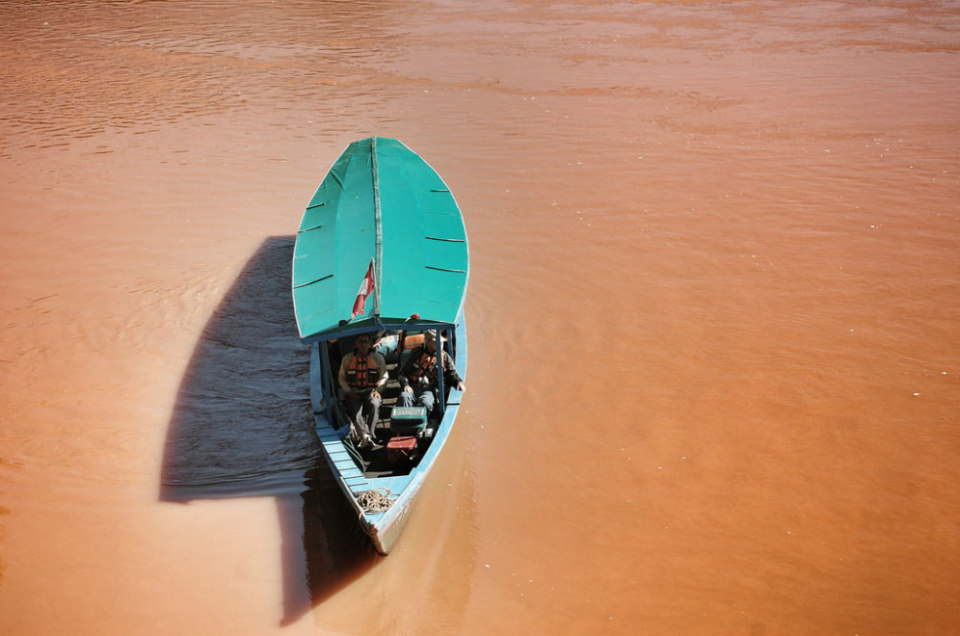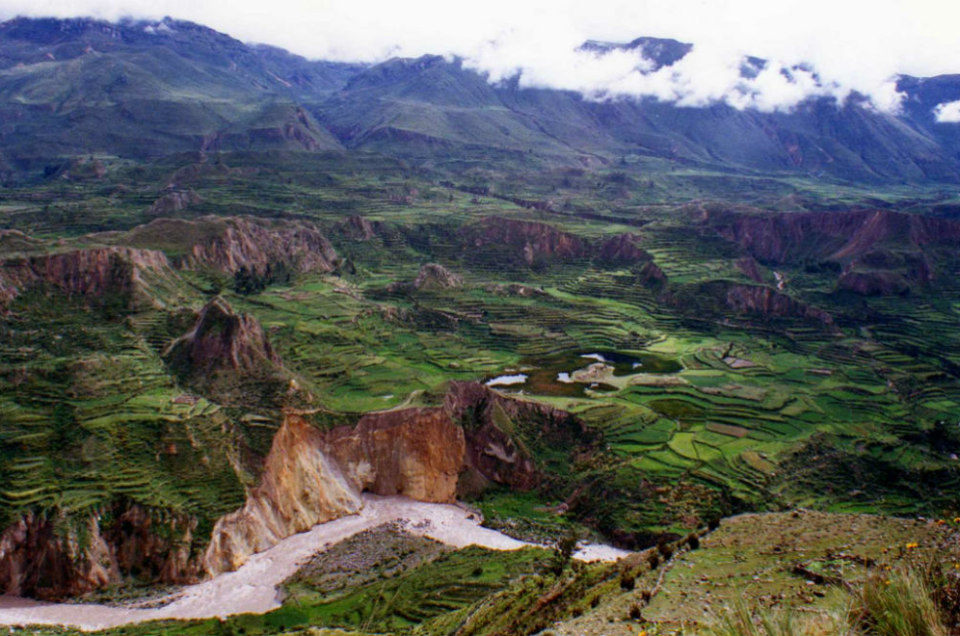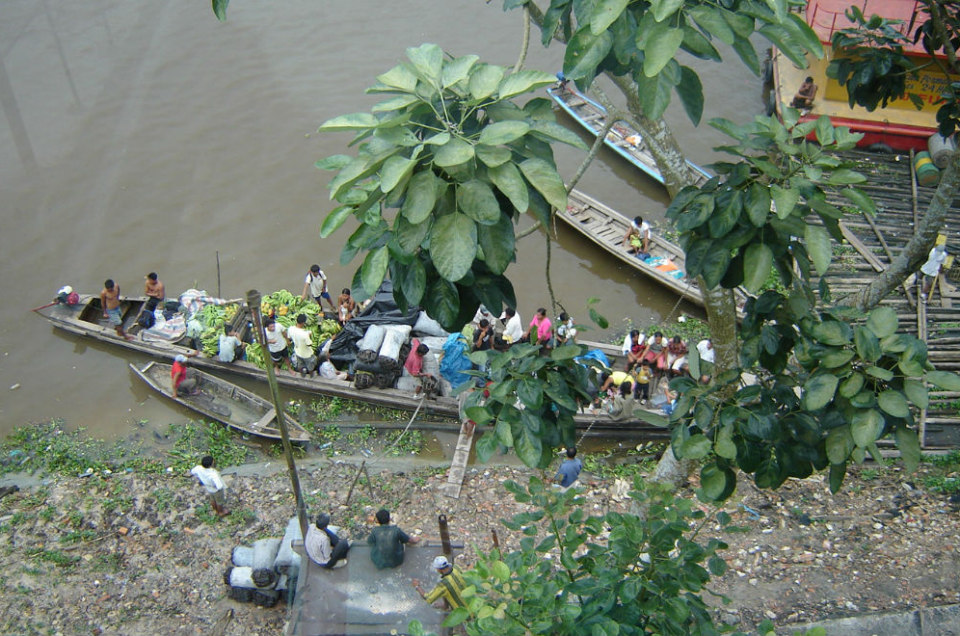In the retelling, the swim probably sounds like a bad idea. Fully cognizant of the fact that a number of normally terror-inducing animals could be hidden down in that brown, murky water—bloodthirsty piranhas, sleek, patient caimans and even the occasional anaconda—I slipped my feet, then my torso, into the surprisingly warm water and, arm over arm, cautiously propelled myself out to the middle of the river.
There, I joined a group of my fellow guests from the Delphin II, a small, boutique, luxury cruise boat that plies the waters of the Ucayali and the Marañon, the two principal headwaters of the Amazon. Later, we would spend some time at the place where the two intersect and form one mighty river—the place that marks the starting point of the world’s greatest waterway. But now, bunched together in a group in the middle of the Rio Ucayali— like kids on Christmas Eve hoping for a glimpse of Kris Kringle—we eagerly dug our feet into the muddy riverbed and awaited the arrival of the mysterious pink dolphin.
It’s not the Peru that most people picture—because when most people picture this South American nation, they think only of Machu Picchu.
And while that sacred site is truly one of the most unforgettable places on earth, I was in Peru for two weeks to see its many other attractions. A diverse country, from its Pacific beaches to its Andean peaks, to the vast, muggy Amazon basin, Peru, now one of Latin America’s economic powerhouses and a new culinary mecca, is a place with a lot to offer. I was off on a fascinating journey, and one with quite a few surprises along the way.
My Amazon adventure began in Iquitos, the world’s largest city unconnected by road to the rest of the world (air and water are the only avenues for arrival). Passing thatched buildings and lush rainforest along the one-and-a-half hour drive to the river town of Nauta (one road connects these two places alone), I arrived at the ship, which looks a bit like an old school cartoon riverboat (but without the paddlewheel)—three decks of comfortable, air-conditioned hammocks, cushy couches and beautiful open spaces, perfect for whiling away a hot afternoon.
But we didn’t have much time for the hammocks. Each of our four days on the river were filled with unique adventures, from a hike through dense jungle amongst playful monkeys, to a walk to a local village and its handicrafts market, an excursion that included fun face-to-face encounters with local residents and even an impromptu football game that brought together cruisers and village kids in one enthusiastic match. We also enjoyed a lovely breakfast onboard small launches that plunged deep into the rainforest on small waterways, taking us into an exotic land of sloths and macaws and electric blue Morpho butterflies, marvels that we viewed while enjoying white-glove service of bacon and eggs, passion fruit and papaya juices and piping hot coffee, followed up by some piranha fishing. And we immersed ourselves in the river, waiting—in vain—for the strange, famous Amazon freshwater dolphin (although we would see several later from the decks of the boat, at the meeting of the two rivers)—then slathering ourselves head-to-toe with therapeutic mud from the bottom of the Ucayali and playing a little volleyball on a sandbar.
And from the steamy depths of the Amazon basin, I travelled to the soaring heights of the Andes, flying from Iquitos to Arequipa, a city that sits more than 7,500 feet up, with a beautifully preserved colonial city centre, which has been designated a UNESCO World Heritage Site. Pausing there for a night, I paid a dinner visit to Chicha, the Andean brand of Gaston Acurio, Peru’s superstar chef, who—as Peruvian cuisine continues to bask in growing worldwide acclaim—is presiding over rapidly advancing worldwide restaurant empire. Serving up Andean and Peruvian favourites, Acurio also dares to play with unique fusions, and I tried one such dish, an Indian curry alpaca, which brought together one of Peru’s most iconic animals with an exotic curry mixed with local fruits.
It was far different than anything I had ever eaten, a culinary confluence of hardy meat, spicy flavours and savory tastes—a delicious combination.
Sufficiently sated, I was ready for a big day on the road, and the next morning I rode much higher into the mountains, at one point traversing a pass more than 16,000 feet up—so high that, when we stopped to inspect the craft items sold by colourful local women along the roadside, the extremely thin air caused me to feel dizzy and confused. We dropped over the other side of the cordillera and into the Colca Valley, a stunning region filled with picturesque, 16th century villages, lined with hulking, snow-capped volcanoes and remarkable terraced slopes that were created and agriculturally cultivated by a pre-Incan civilization (it’s not surprising that Mario Vargas Llosa called Colca “the Valley of Wonders”).
Bumping along a dusty road clinging to the flanks of the mountains, we arrived at a true national treasure—the Colca Canyon, twice as deep as the Grand Canyon and home to the majestic Andean condor, an unmistakable symbol of Peru. Joining the crowd gathered at a landmark called the Condor Cross, we thrilled at the sight of the giant birds, which swooped over the great depths of the canyon, riding its warm updrafts with their ten-plus-foot wingspans. Although you could hear a pin drop amongst the amassed observers, the haunting tune of the Flight of the Condor on pan flute played in the back of my mind as I watched the smooth, languid, awe-inspiring flight of these birds.
But no trip to Peru would be complete without a trip to Machu Picchu. On one of my final days in the country I travelled there, taking the first-class route—an Orient-Express train to the base, and a chartered bus to the top. And it was magnificent. It was everything that I expected it to be. But instead of the sum total of my experiences, it was the conclusion, the final curtain on a diverse and wonderful adventure.


